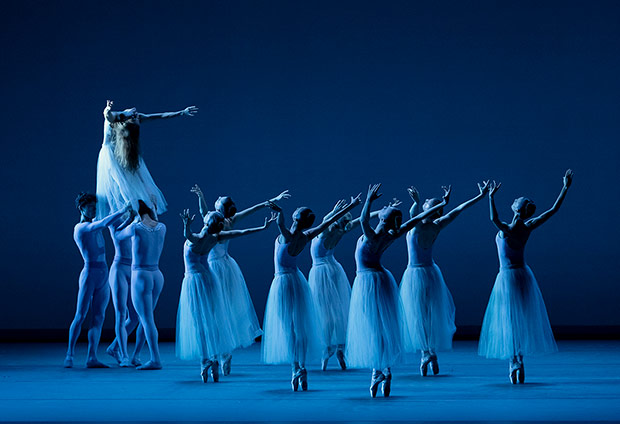
© Paul Kolnik. (Click image for larger version)
Balanchine: The City Center Years – opening night
Miami City Ballet: Serenade
Mariinsky Ballet: Tchaikovsky Pas de Deux
The Royal Ballet: Tarantella
New York City Ballet: Symphony in C
★★★✰✰
New York, New York City Center
31 October 2018
www.nycitycenter.org
Balanchine-A-Rama
It’s a testament to the global reach of George Balanchine’s ballets that New York City Center has been able to put together a five-day festival of his works with the participation of eight companies from around the country and the world. City Center was of course Balanchine’s first stable home in America; it was here that the various troupes he and Lincoln Kirstein put together since his arrival in 1933 could finally consolidate under the banner of the New York City Ballet, in late 1948. And it was here that he created the foundation of the company’s repertoire, everything from his Nutcracker to Agon to Liebeslieder Walzer to Square Dance.
The festival, which is part of City Center’s 75th anniversary season, brings three companies from abroad: the Mariinsky, the Royal Ballet, and the Paris Opéra. As well as five American troupes: American Ballet Theatre, The Joffrey Ballet, Miami City Ballet, San Francisco Ballet, and of course the company formed by Balanchine himself, New York City Ballet. One can grumble about the choice of repertoire. A certain number of the ballets are slight (like Tchaikovsky Pas de Deux) or incomplete (they are only showing the pas de deux from Agon, not the whole thing). And most of the works, with the exception of the Glinka Pas de Trois and Scotch Symphony, are familiar. It would have been nice to get a few more rarities, like Ivesiana, or the Sylvia Pas de Deux.
But this selection is also an indication of which Balanchine ballets have “stuck” in the international repertoire: the more conventional neoclassical pieces, the bravura pas de deux (like Tarantella), and of course Apollo, one of his great male showpieces. (The latter will be performed by Xander Parish of the Mariinsky on Nov. 3.) Opening night offered a program designed to please: the universally-loved Serenade, two showstoppers (Tchaikovsky Pas de Deux and Tarantella) and the grand and glittering Symphony in C, its ranks slightly reduced to fit the City Center stage.
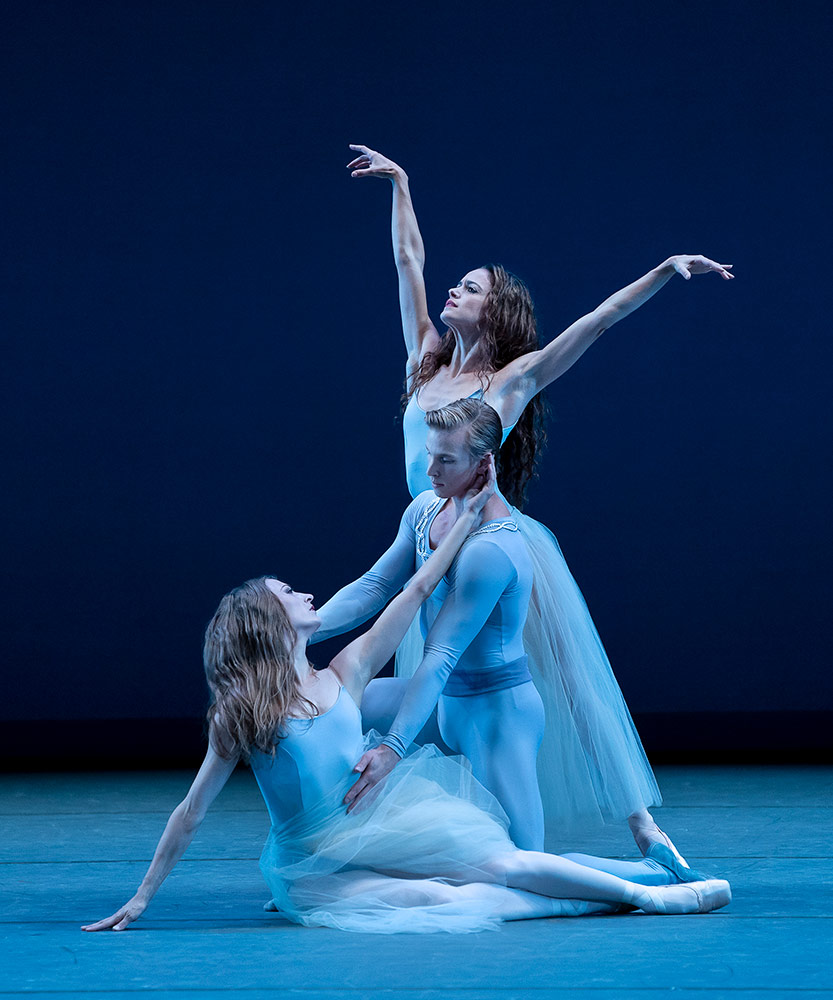
© Paul Kolnik. (Click image for larger version)
A few jitters were natural – such a showcase puts immense pressure on companies to rise to the occasion. Miami City Ballet, who opened the evening with Serenade, started off with a slight case of nerves, manifested in slips here and there. Still, the performance, led at breakneck speed by the New York City Ballet orchestra under the baton of Andrews Sill, was exciting, a blur of bluish tulle. The Miami dancers pushed through the air almost hungrily. City Ballet is assertive, stylish, and sharp; the Miamians dance with drive. And at the same time, they’re “neater” – they stay in their lines and hold their arms at the same angle. Not something City Ballet is known for, as the performance of Symphony in C attested. It’s fascinating to see the two companies side by side, like siblings with different temperaments.
Jeanette Delgado most vividly embodied Miami Ballet’s approach: full-bodied, warm, propulsive. Her plié is deep; you felt it in your own body. And the way she folded and bent her upper body added texture and modulation to each phrase. She danced in three dimensions at all times. There is also a particular warmth to her stage presence. In the role of the leader of the “Russian” dance, she smiled and looked into the faces of her fellow dancers, offering her hand with simplicity and feeling. More generally, the company tended to illuminate touches of narrative in the ballet that one seldom notices; the ending, in particular, suggested a real leave-taking rather than a more abstract apotheosis.

© Paul Kolnik. (Click image for larger version)
It’s fascinating to see how Balanchinean charm and wit are interpreted by dancers for whom the Balanchine repertoire is more of a foreign language. The Mariinsky’s Viktoria Tereshkina and Kimin Kim in Tchaikovsky Pas de Deux were a perfect example of the way subtleties can be lost in translation. The technique, of course, is brilliant (they’re both stars for a reason) but the jokey, throwaway spirit of the thing was lost. Tereshkina flirted with her eyes and shoulders. At the end of the first a section, she turned her face toward her partner ever so slowly, to calculated effect. Kim wowed the audience with the truly amazing lift in his jumps; just when you thought he had reached the apex, he seemed to get an extra push and hovered there a bit longer. More than once, it seemed he might land in the orchestra pit. But the pas de deux felt stagnant; it didn’t rise and accelerate toward its celebratory ending.

© Paul Kolnik. (Click image for larger version)
Tarantella, another bauble, this one in “Neapolitan” style, was truer to form. Marcelino Sambé, a first soloist at the Royal Ballet, had the charm and the jump for the tambourine-smacking male role; Anna Rose O’Sullivan, a soloist, was pert and quick, with perfectly centered turns. The two egged each other on, never losing the edge of playful, buoyant competition that gives this pas de deux its raison d’être.

© Paul Kolnik. (Click image for larger version)
Symphony in C closed the evening. Despite the smaller stage, New York City Ballet looked comfortably at home in this sparkling showpiece. The proximity of the stage at City Center makes this work all the more dazzling, with its grand formations and rat-a-tat footwork. For the occasion, the company brought out a cast that was sure to hit its mark: Tiler Peck, whose dancing is so inside of the music that the music seems to actually emanate from the movement itself; Sara Mearns, in high dramatic form (despite a stumble) in the slow, mysterious second movement; Ashley Bouder and Anthony Huxley well matched in the action-packed third; Lauren King and Taylor Stanley frisky and joyous in the fourth. As usual the dancers’ arms weren’t perfectly matched, and the lines of the corps were not always straight. But the musicality was taut, like a spring.

© Paul Kolnik. (Click image for larger version)
But then, this is home territory for City Ballet. And the company is performing with a particular sense of urgency these days, as if it has something to prove after the scandals surrounding the departure of its former leader and three top dancers. The repertory is its lifeblood.
The festival runs through Nov. 3.













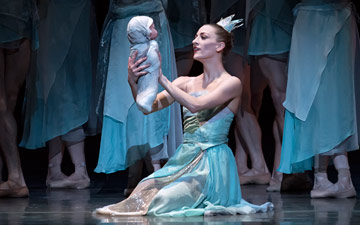
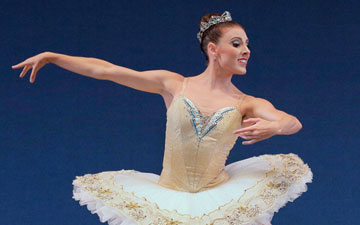

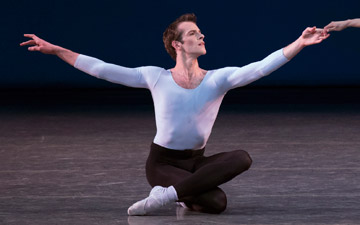
You must be logged in to post a comment.